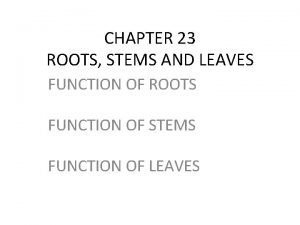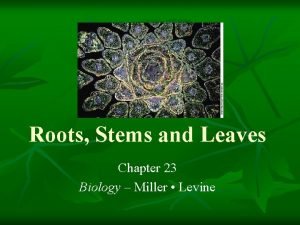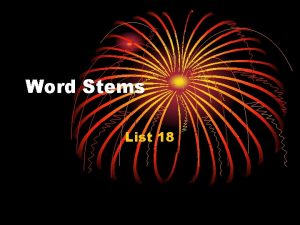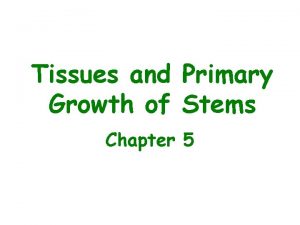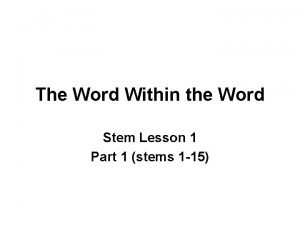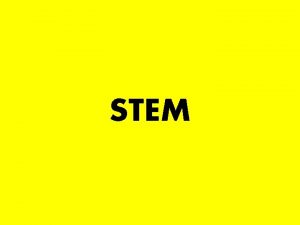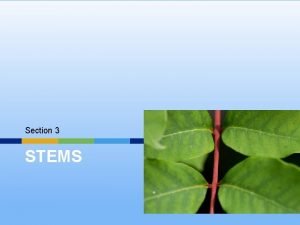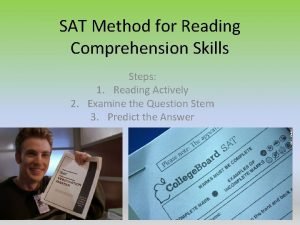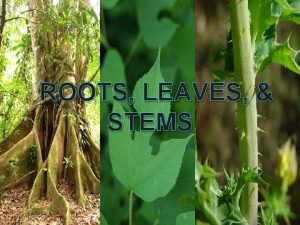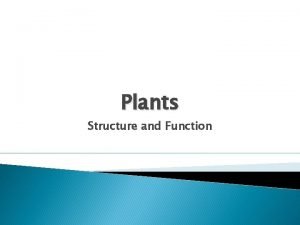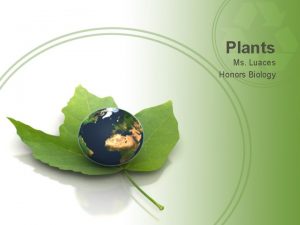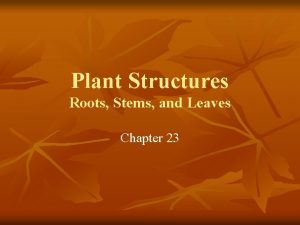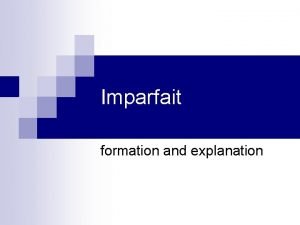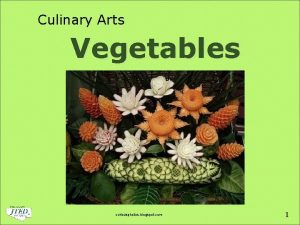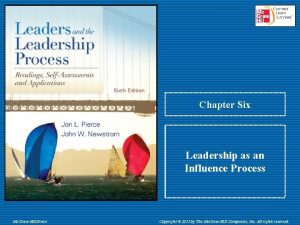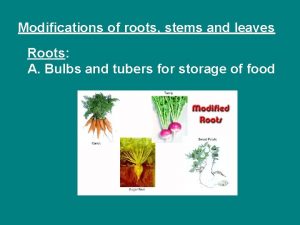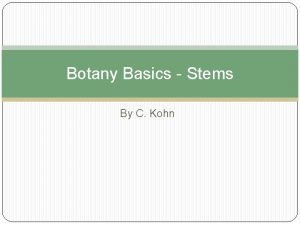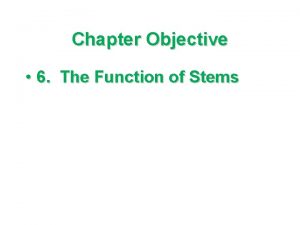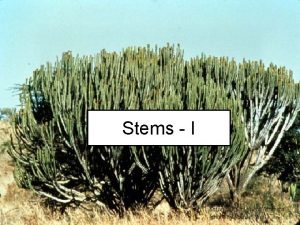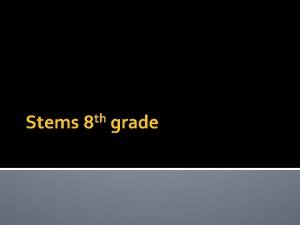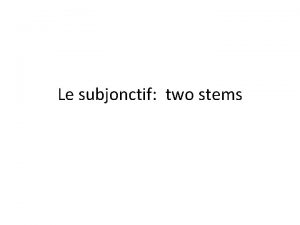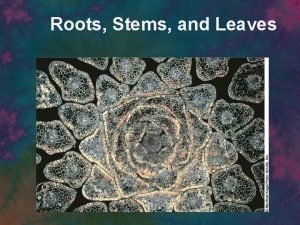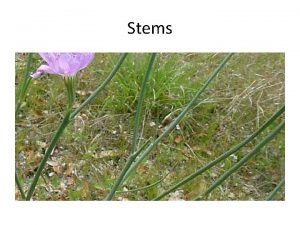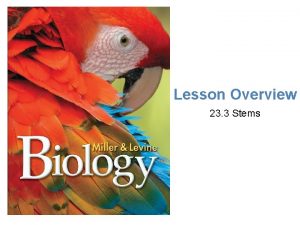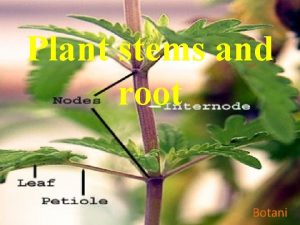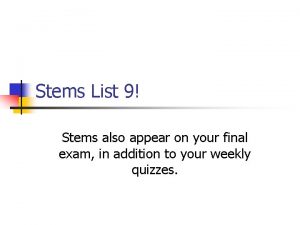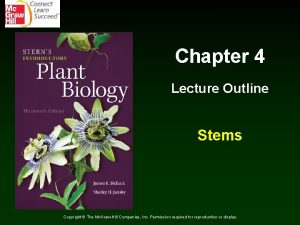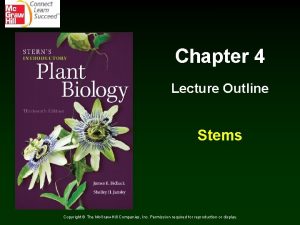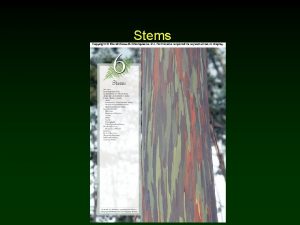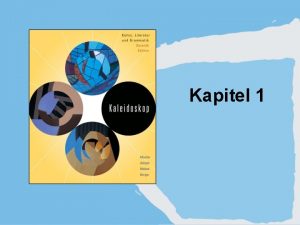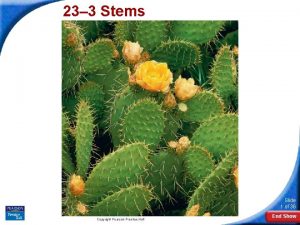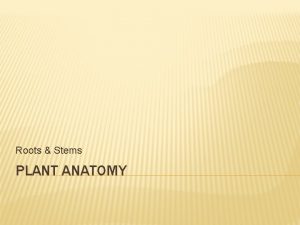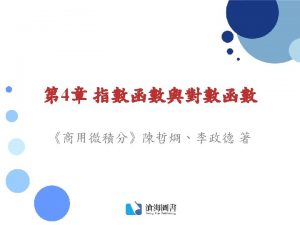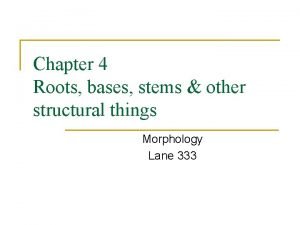Chapter 6 Lecture Outline Stems Copyright The Mc


























- Slides: 26

Chapter 6 Lecture Outline Stems Copyright © The Mc. Graw-Hill Companies, Inc. Permission required for reproduction or display.

Outline v External Form of a Woody Twig v Origin and Development of Stems v Tissue Patterns in Stems • Herbaceous Dicotyledonous Stems • Monocotyledonous Stems • Woody Dicotyledonous Stems v Wood and Its Uses v Specialized Stems

I. WOODY AND HERBACEOUS PLANTS II. External Form of A Woody Twig-Gross Structure v Shoot System _____________. v Woody Twig– gross structure. • Node = ________________ - Arrangement of nodes—Arrangement of Leaves on Stem - Alternate or spiral - Opposite - Whorled • Internode = _______________ • Leaf = _________________.

• Axil - Angle between petiole and stem BUDS • Bud scales: ________ – Function = _______ • Bud Scale Scars: group of bud scale scars for one year around stem; indicates age • Bud Contains: Apical Meristem, Leaf Primordia, Bud Primordia • Axillary Bud located in ______. – Growth in _________ • Terminal Bud – Location: __________ – Growth in: ______

• Stipules - Paired, often leaflike appendages at base of a leaf • Deciduous: _____ – Appearance of Twigs: • Bundle scars mark food and water conducting tissue within leaf scars.

III. Origin and Development of Stems v Apical meristem at stem tip • Contributes to increase in stem length • Dormant before growing season begins • Protected by bud scales and by leaf primordia – Leaf primordia - Tiny embryonic leaves that develop into mature leaves Longitudinal section through stem tip

Stems & Leaves in Embryonic Plants in a Seed v Cotyledons - Seed leaves attached to embryonic stems • Store food needed by young seedling • Dicotyledons (Dicots) - Flowering plants that ___________ • Monocotyledons (Monocots) - Flowering plants that _________________

IV. Tissue Patterns in Stems v HERBACEOUS PLANTS Stele - Central cylinder of primary xylem, primary phloem, and pith (if present) Eusteles - Discrete vascular bundles – In flowering plants and conifers Vascular Bundles

MATURE TISSUES– Microscopic View Herbaceous Dicotyledonous v Epidermis v Vascular Bundles = • Tissues: • Arrangement of bundles: v Secondary Growth: some v Cortex: Area ___________ v Pith: Area _______________ Dicot

Monocotyledonous v Monocots • Epidermis • No Secondary Growth Cross section of monocot stem • Vascular Bundles– location: – Xylem closer to center – Air Space – Fibers (sheath) • No Pith or Cortex – Parenchyma surrounds bundles. Monocot vascular bundle

Woody Stems v v Woody Plants: have lateral meristems • ____________________ • Secondary Growth = Pattern of Tissue • Bark – Periderm o – Cork Cambium 2 nd Phloem • Vascular Cambium • 2 nd Xylem • Pith

Woody Dicotyledonous Stems v Wood = Secondary xylem v Activity of Lateral Meristems • Seasons: Annual Rings – – – Spring wood: secondary xylem w/ _________ Summer wood: s” “ _____ In conifers: have Tracheids • No Seasons Tropics:

v Annual Ring = – Angiosperms: mostly vessel elements – Bulk of tree trunk consists of annual rings of wood. • Age • Climate v Vascular Cambium: v Phloem: Cross section of young stem with secondary growth v Vascular Ray: horizontal row of parenchyma • Function: • Xylem Ray • Phloem Ray -

Bark Cross section of young stem with secondary growth

Wood Categories v Heartwood: older, darker, in center • Parenchyma cells accumulate • Prevent conduction of water • Resin Canals • Gums tannins v Sapwood: functional v Softwood v Hardwood Resin canals in pine

VI. Wood and Its Uses v 50% of weight = water content. • Dry part = 75% cellulose + 25% lignin. v Density - Weight per volume v Durability - withstand decay • Tannins and oils

v Knots - Bases of lost branches v Wood Products • lumber – Sawdust and waste = particle board and pulp. – Veneer • Pulp --Paper, synthetic fibers, plastics, linoleum • Ifuel. – 10% in US

v Bark – Periderm and Phloem • Secondary Phloem = Inner Bark • Laticifers - Ducts have latex-secreting cells • Rubber, chicle (chewing gum), morphine

v Periderm = Outer Bark • Cork Cells • Cork Cambium • Other • Function Periderm Bark Cross section of young stem with secondary growth

• Lenticels – made from Parenchyma cells – Function: ___________ Gross View Early Development Mature Lenticel

V. Specialized Stems v Rhizomes - Horizontal stems just below-ground • Irises, some grasses, ferns v Runners - Horizontal stems • Make new plants at end • Strawberry v Stolons - Produced beneath the surface & give rise to tubers. v Tubers– next slide

v Tubers - Swollen, fleshy, underground stem • Store food • Potatoes - Eyes = nodes for making new plants v Bulbs - Large buds with fleshy leaves & small stem • Store food • Make new plants • Onions, lilies, hyacinths, tulips

v Corms – mostly stem tissue, with papery leaves • Store food • Make new plants • Crocus & gladiolus v Cladophylls Flattened, leaf-life stems • Photosynthesis • Store water • prickly pear cactus Prickly pear cactus

Review v External Form of a Woody Twig v Origin and Development of Stems v Tissue Patterns in Stems • Herbaceous Dicotyledonous Stems • Woody Dicotyledonous Stems • Monocotyledonous Stems v Specialized Stems v Wood and Its Uses

Life Span of Plant v Annuals - Plants that die after going from seed to maturity within one growing season • Type of Plant: • Monocot or Dicot: • Primary or Secondary: v Bienial v Perrennial

 01:640:244 lecture notes - lecture 15: plat, idah, farad
01:640:244 lecture notes - lecture 15: plat, idah, farad Section 23-2 roots answer key
Section 23-2 roots answer key Internodes
Internodes Lecture outline example
Lecture outline example Lecture outline example
Lecture outline example Lecture outline example
Lecture outline example Lecture outline meaning
Lecture outline meaning Sandwich
Sandwich Stems list 1
Stems list 1 Companion cell
Companion cell Lesson 1
Lesson 1 What is the function of stems?
What is the function of stems? Plants with soft green stems are called
Plants with soft green stems are called Vascular bundle in stem
Vascular bundle in stem Moonwalking with einstein sat answers
Moonwalking with einstein sat answers What is the function of stems?
What is the function of stems? What is this
What is this What is the function of stems?
What is the function of stems? Venus fly trap structural adaptation
Venus fly trap structural adaptation Crown plants examples
Crown plants examples Imparfait explanation
Imparfait explanation Higher order thinking iteach flashcards
Higher order thinking iteach flashcards Blogspot dmca
Blogspot dmca Power stems from internalized values in p which dictate
Power stems from internalized values in p which dictate Modifications of roots
Modifications of roots Closing sentence stems
Closing sentence stems Above ground horizontal stem
Above ground horizontal stem

